Your cart is currently empty!
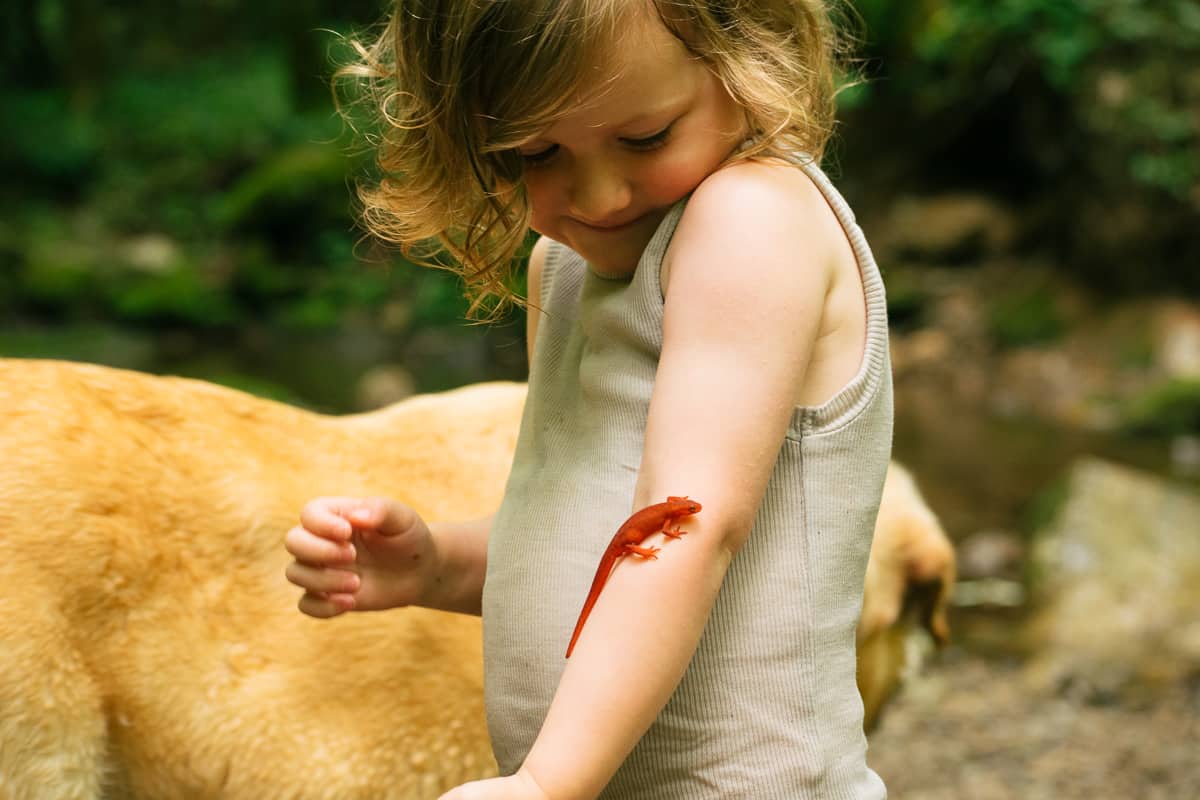
Discovering the Wonders of Salamanders with Kids
Exploring nature with kids is always an adventure. There are so many things for them to discover and learn with their senses. Sometimes, they find new plants and creatures that even we parents know very little about. This can be unnerving because we don’t always know if it is safe for our children to explore. Salamanders, with their bright colors, potential toxicity, teeth, and generally strong ability to remain unseen, are one such creature many parents may be wary of when stumbling upon one in nature. Not to fear, Somer Pickel, Creative Team member, and nature-loving Tennessee mom shares everything you will ever need to know about discovering salamanders with kids.
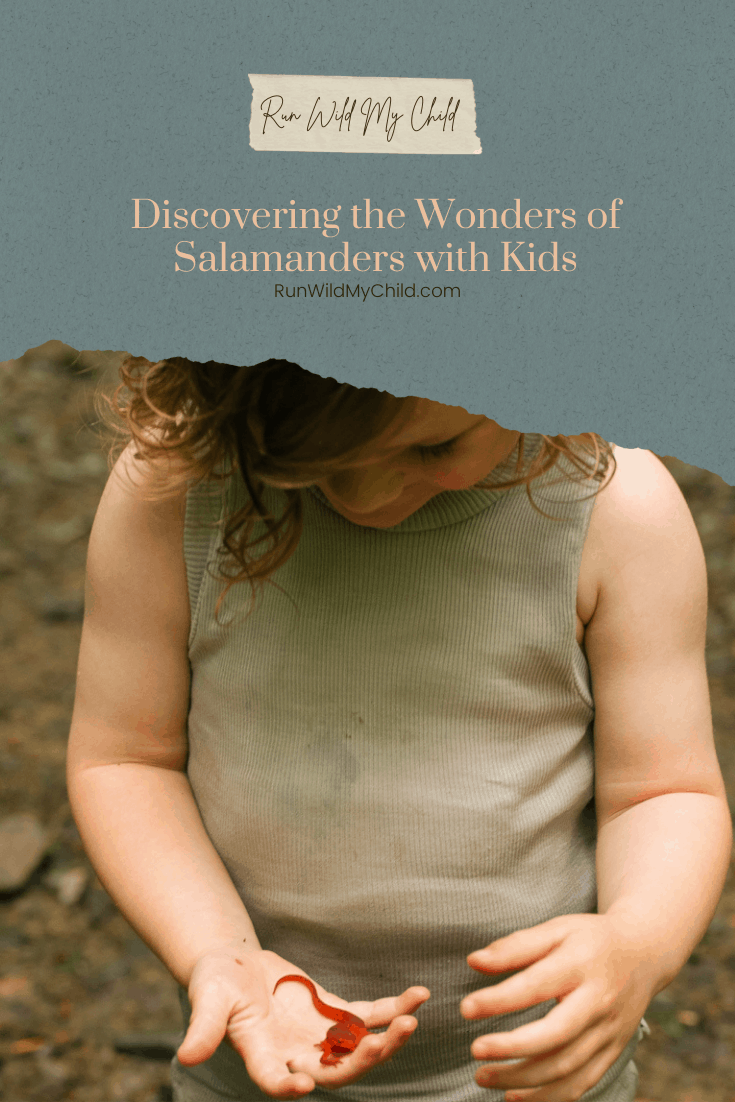
Teaching kids to love nature through sensory experiences
The cognitive, emotional, and physical benefits for kids spending unstructured time outdoors are well documented. And I am guessing you wouldn’t be on this website if you didn’t already believe in the wonders of time spent outside. But how do we get our kids to defy the allure of screens and seek more time outdoors?
What if we could help our children foster a personal relationship with the natural world? If our kids develop a passion for being outside, they’ll take more interest in leaving the screens behind. I’d argue the most long-lasting (and fun) way to encourage your child’s love for the outdoors is through complete and total immersive play. Our kids are sensory beings. They learn most easily when they’re having fun and allowed to explore.
In less fragile areas (and where you have permission), let them venture off-trail to experience the thrill of wandering and independent discovery. Let’s encourage them to literally delve in and make their own connections. Mother nature is tough, surely she can handle a bit of child’s play.
It may seem like it on the surface, however, I’m not promoting the abandonment of leave no trace (LNT) principles. LNT values have their place. But too, if all our kids are never granted the freedom to roam or learn as their little heart’s desire, how will they connect with the natural world? So, from time to time, seek balance. Let your child run wild and discover salamanders in their natural habitats.
Why salamanders?
I am sure some of you are wondering what any of this has to do with salamanders. Why should you discover salamanders with kids? Well, these adorable little creatures are a great means to actively engage and immerse your children in nature. Salamanders are a mostly harmless, yet abundant, class of critters that your kids can explore safely (with supervision).
They’re also quite elusive. To have any luck finding them, kids will have to put in effort learning about their habitat, behavior, and activity. They’ll need to get out and trek through the animals’ natural habitats if they are to have the honor of eyeing one of these guys up close. Discovering salamanders could be your child’s window into the wonders of nature.
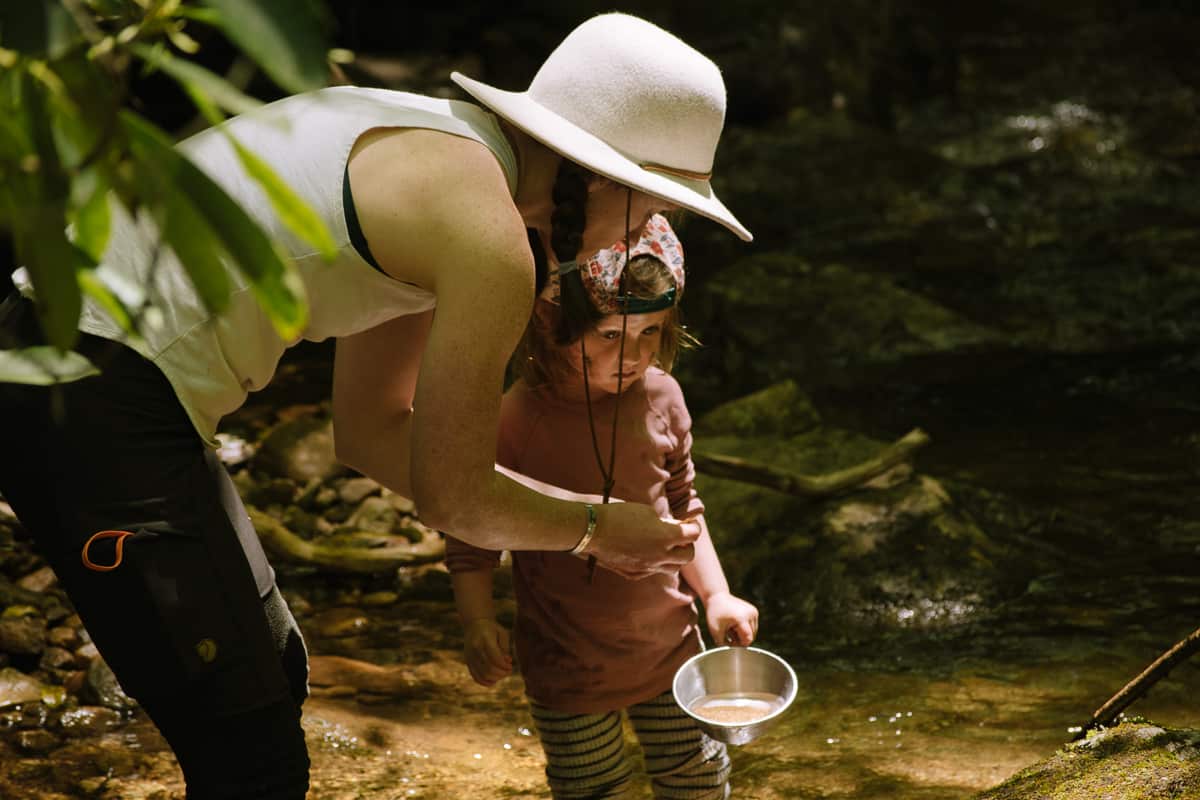
What are salamanders?
Salamanders are in the amphibia class along with frogs. Within the amphibia class, they are members of the Caudata order, meaning “tail” in Latin. Like other amphibians they are cold-blooded critters who (mostly) remain tied to water.
Salamanders either live wholly aquatic lives and/or lay their shell-less eggs in it. Their eggs hatch into larvae, which resemble tadpoles, and stay in the water until they metamorphosize weeks or months later. During this process, they grow limbs and tails.
Once mature, most salamanders are like lizards in shape. They tend to have elongated necks and bodies with lengthy tails. But unlike lizards, they lack claws and scales. In lieu of scales, they sport thin permeable skin. And instead of claws, most have adorable little toes. Though, some species lack legs altogether and tend to look more like eels.
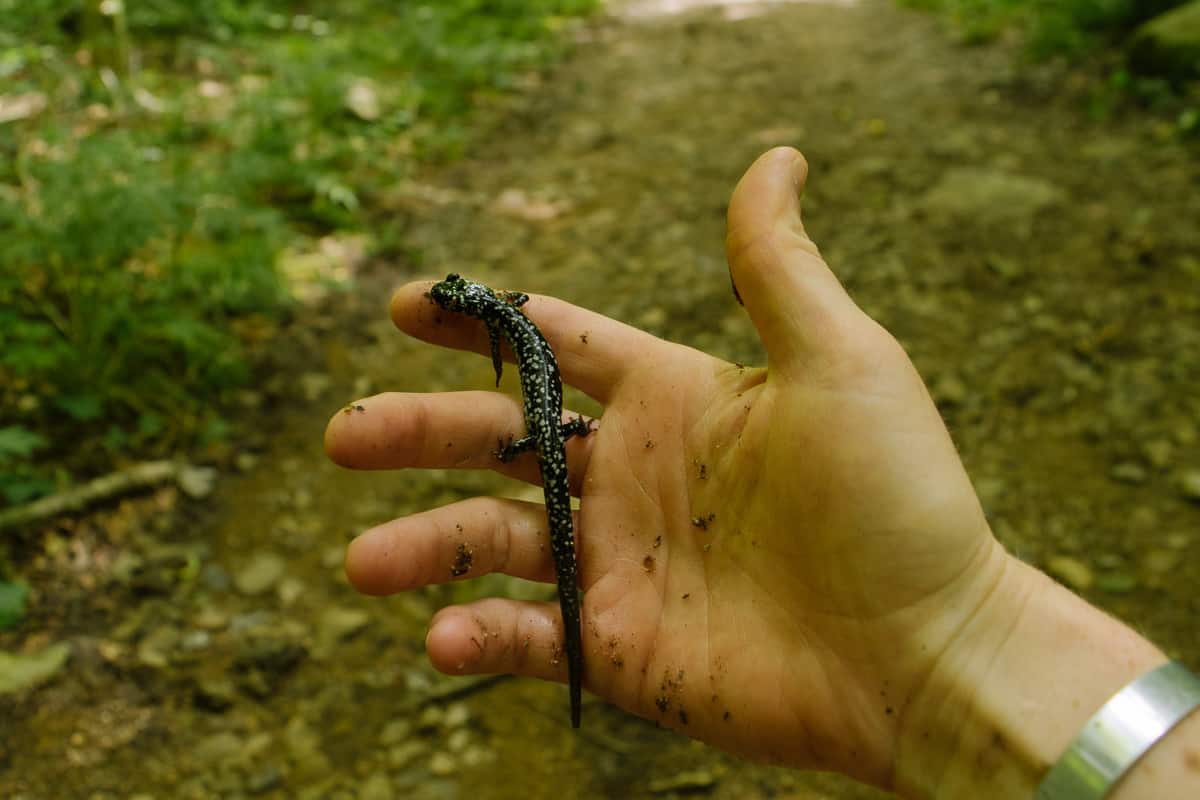
Where do salamanders live?
Salamanders can be found all over the world, with Australia and Antarctica being the exceptions. But, they are most abundant in the northern hemispheres. Those found in the southern hemisphere tend to be in mountainous regions or the Amazon basin.
Like all amphibians, salamanders’ permeable skin makes them unable to survive saltwater. So, while salamanders do boast quite an impressive range (from nearly the arctic circle of Russia to Bolivia’s Andean Mountains!) they aren’t found in oceans, salt marshes, estuaries, or tidal creeks.
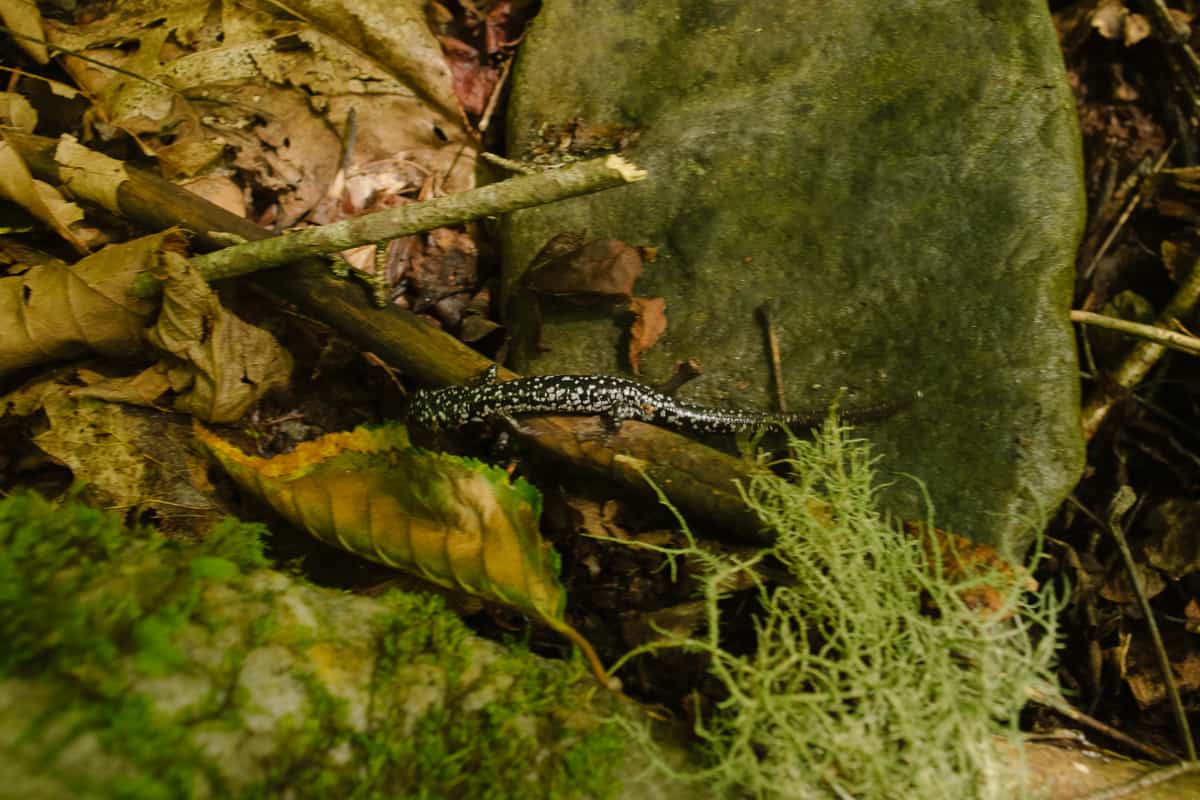
Salamander diversity in the US
The United States is home to 186 distinct species of salamanders, which is about a third of the world’s salamanders! Though salamanders can be found almost anywhere in the U.S., four regions contain particularly high concentrations and diversity. The areas are the Pacific Coast; Edwards Plateau region in Texas; Ozark and Ouachita mountains in AR, MO, and OK; and the Southeast.
As a fourth-generation Tennessean, I was shocked to learn the American Southeast has the highest genetic diversity of salamanders in the world (who knew?!). On that note, all photos in this article are of salamanders native to the southern Appalachian region.
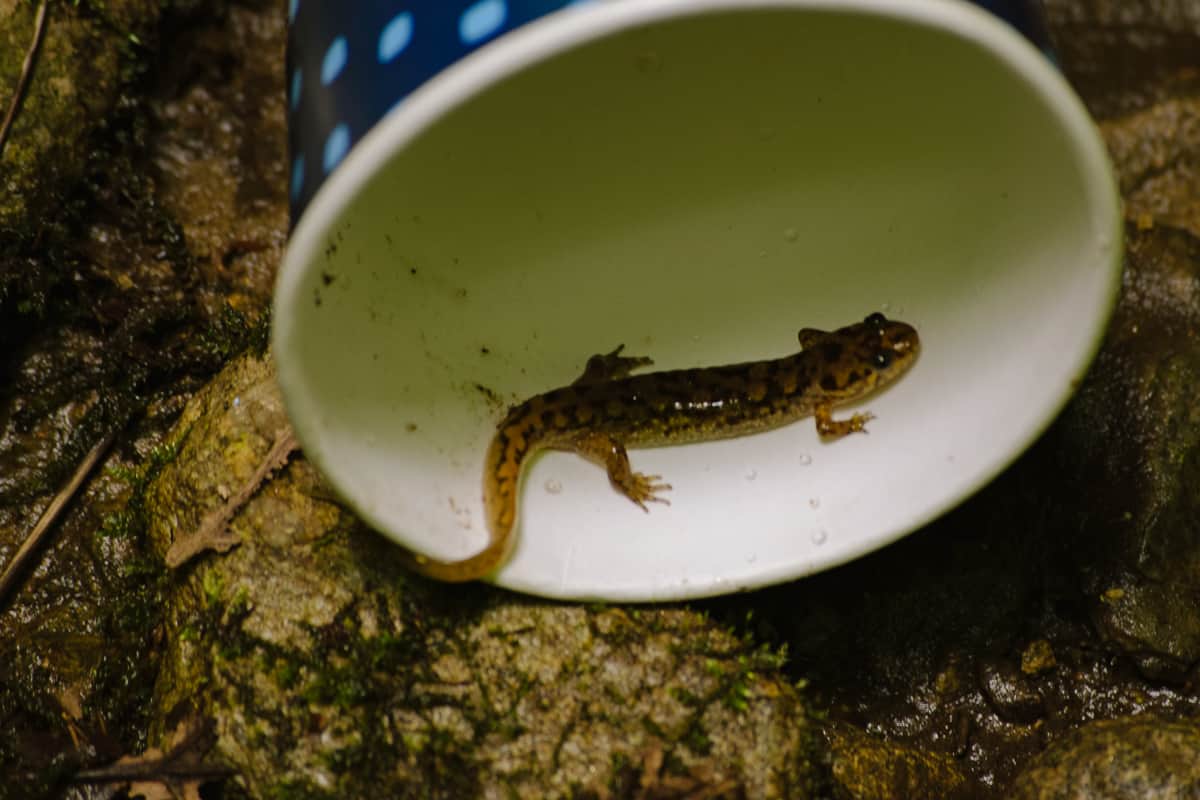
Salamander habitat
Salamanders are extremely diverse across species, including the habitats they call home. Some salamander species are aquatic and spend their whole lives submerged in creeks, bogs, swamps, ponds, rivers, or lakes. Others live in caves, freshwater seeps, terrestrially in forests, or burrowed within moist forest soil.
Many terrestrial species tend to return to the same water source each breeding season. Some salamander species have been known to travel up to nine miles back to the vernal pond where they were born. Imagine traveling that far on teeny legs! After breeding, the new generation hatches and metamorphosizes within the water source. Then they find their way onto land.
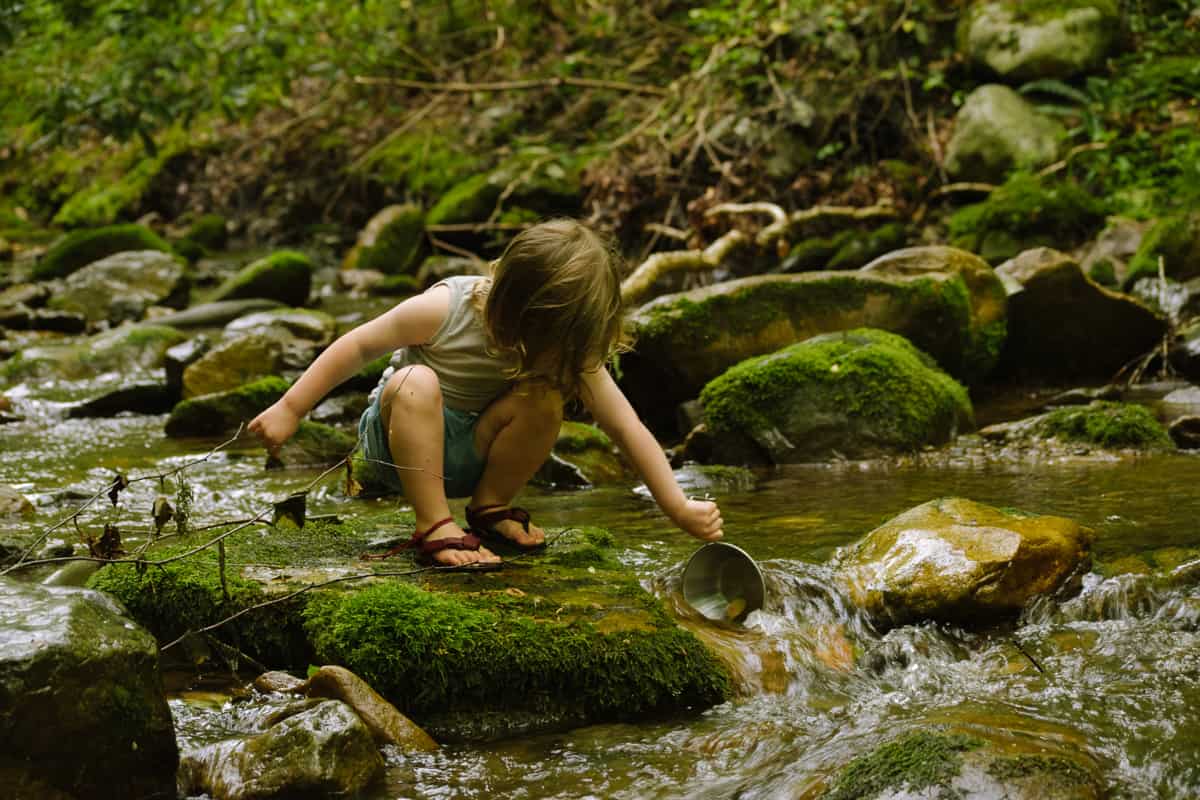
Salamander size
In case you weren’t already thoroughly impressed with these under-rated amphibians, they also have huge variants in size. And I am not talking about a pound or two’s difference. While some salamanders only ring in at a couple of inches, others grow upwards of 6 feet and >60lbs! (I know, crazy right?!)
The Southeastern U.S. has a species called the Hellbender that can grow up to a couple of feet long (though unfortunately, they’ve become quite rare). The largest terrestrial species are members of the mole salamander suborder and endemic to North America. Some of these species, such as the tiger salamander, can be more than 8 inches long. However, most salamanders that you’re likely to find on your adventures will be less than 6 inches.
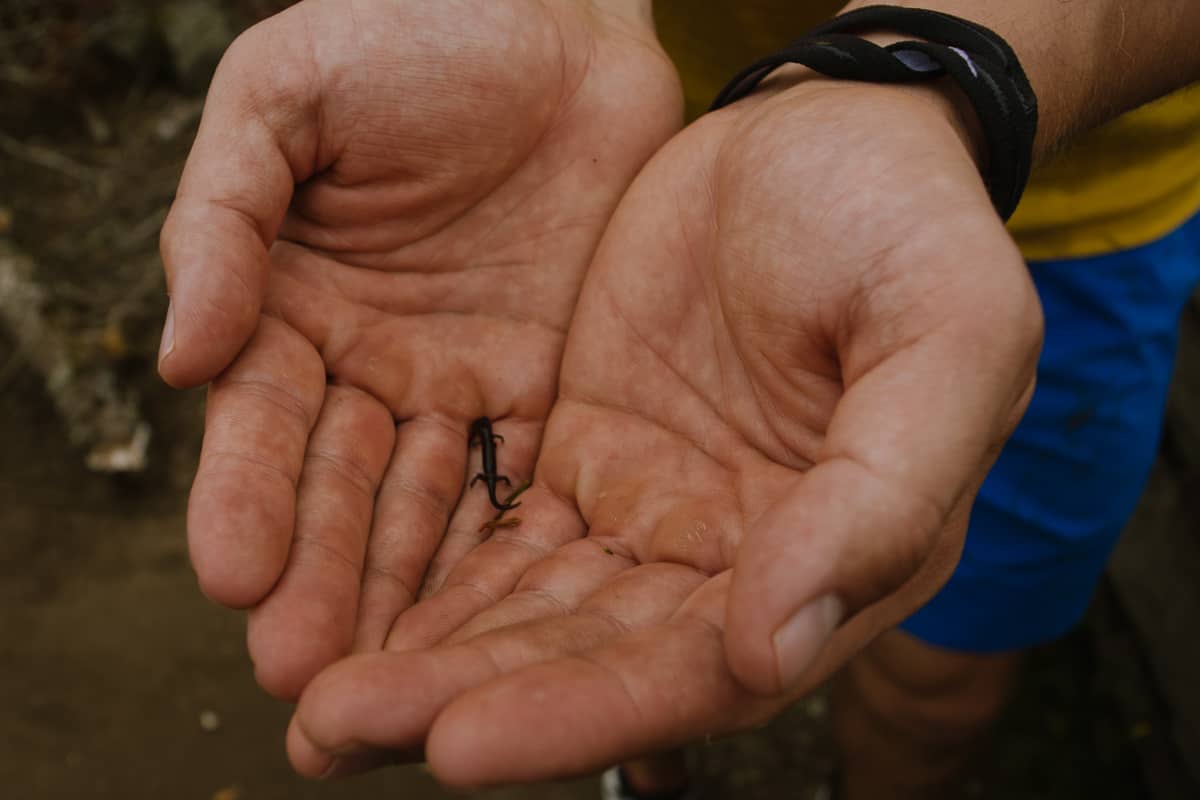
Salamanders are carnivores
Salamanders are carnivores from the larval stage through adulthood. Adult terrestrial species tend to consume a wide variety of invertebrates including millipedes, centipedes, insects and their larvae, snails, and earthworms. But large mole salamanders may go as far as to eat small mice, shrews, and snakes. Aquatic species feed on fish, crawdads, zooplankton, mosquito larvae, and even other salamanders.
Some North American mole salamander species, such as the tiger salamander, require only a few meals a year. Uniquely for cold-blooded animals, they tend to function better at lower temperatures. They’re able to conserve energy and go long periods between meals because they’re more active in colder temperatures. Some species go into a mostly dormant state in their burrows during the hot summer months.
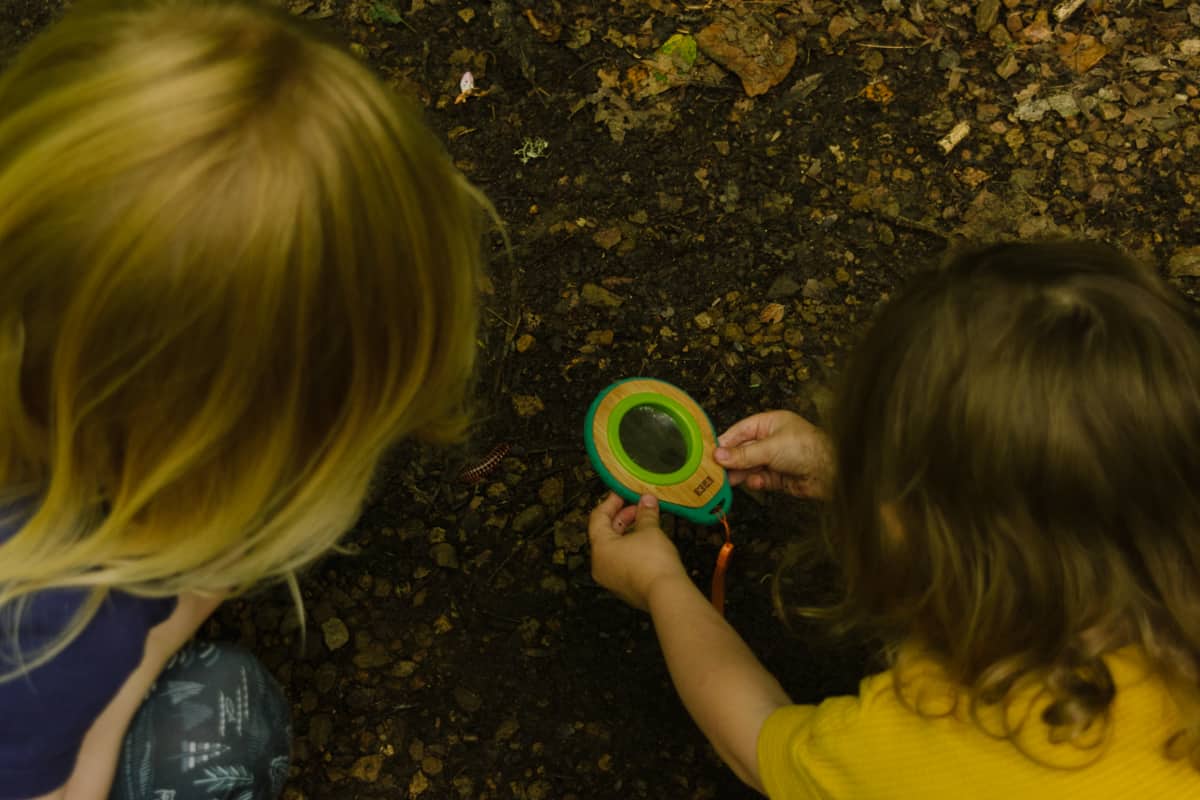
Salamander color diversity
There’s an incredible amount of body coloration diversity within the >575 known species of salamanders. They come in a myriad of colors, ranging from camouflaging browns, dramatic neons, and even translucent in some cave-dwelling species.
Biologists who study reptiles and amphibians believe the brightly colored salamanders evolved their beautiful tones as a toxicity warning to their potential predators. As shown in some of the photos within this article, the Eastern U.S. has some strikingly bright species.

Salamander toxicity
On that note, yes, some salamanders are poisonous. However, you must ingest the salamander for it to be of any harm. I don’t think this article will lead folks to run off into the forests to catch and eat salamanders, but let’s just throw it out there, *salamanders are not safe for human consumption*.
For all practical purposes, if your kids wash their hands after handling, they’ll be alright. However, it’s worth noting some of the larger species, namely Hellbenders, pack a mouth full of teeth and can bite. If you and your kids find the motivation to explore and discover these critters, you may want to stick to the smaller species.
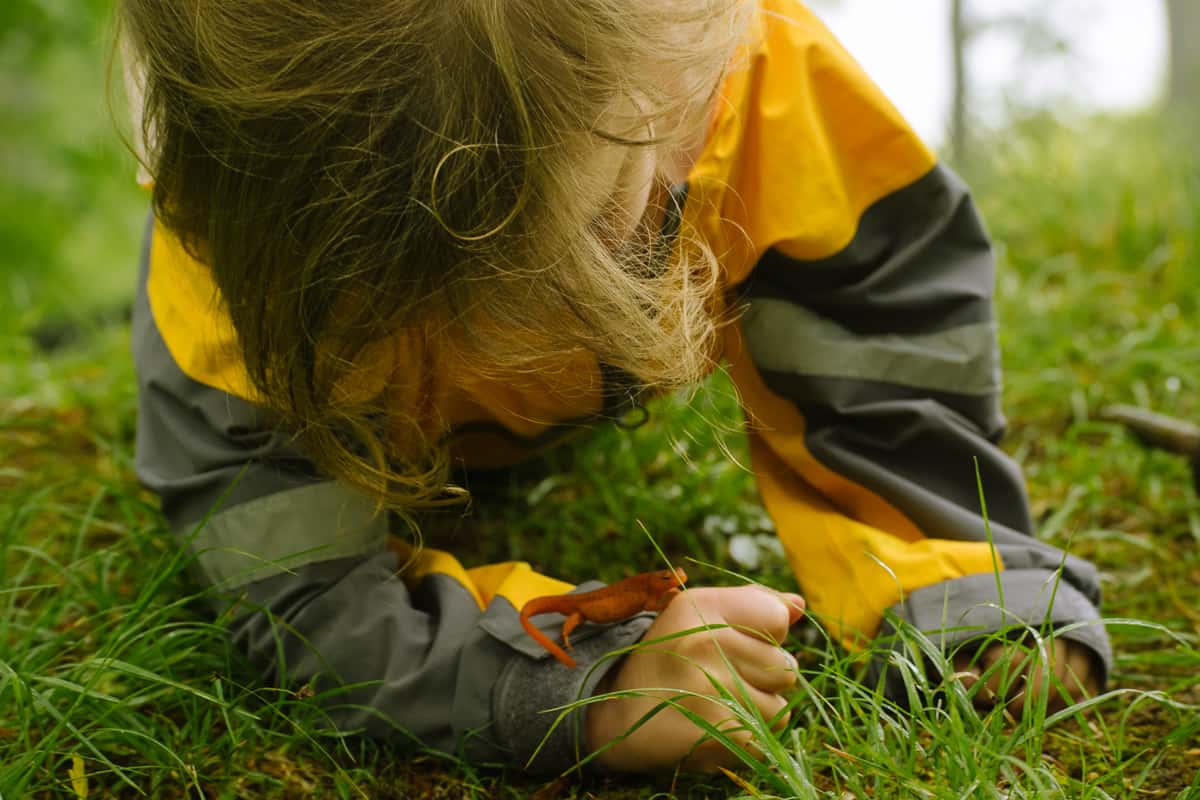
Salamander lifespans
If you’re anything like me, then you may equate a critter’s small size with a short life span. That’s not the case with salamanders. These typically small vertebrates have uncharacteristically long lives. Some span decades.
Hellbender lifespans can be upwards of 30 years, and spotted mole salamanders can live up to 20 years. There are accounts of giant salamander specimens in Japan and China living 60-70 years! With such long lives, I guess it’s not surprising that some species, like the eastern newt, spend years in their juvenile stages before metamorphosizing into their adult forms.
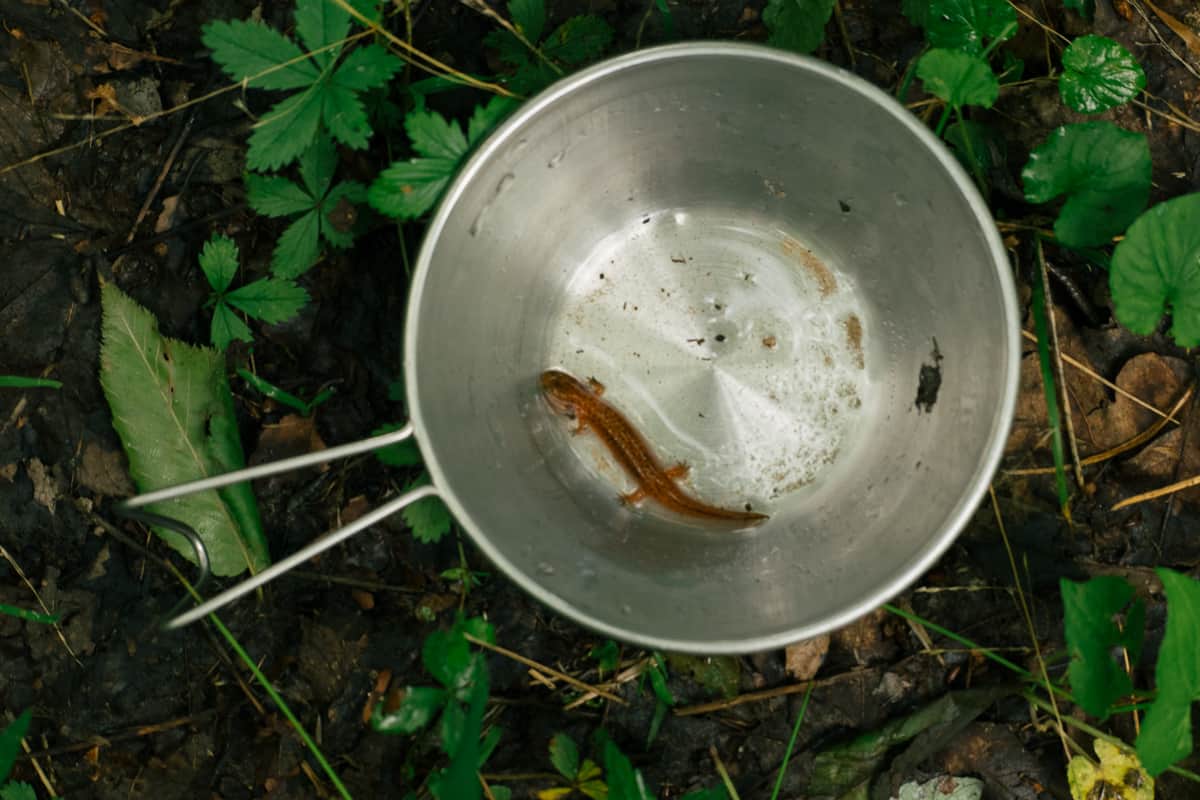
Salamander skin
Another distinctly amphibian characteristic is the salamanders’ skin. They sport thin permeable skin that must be kept moist. Even so, there’s a lot of diversity in how a salamander’s skin can feel. Some are mucous-covered and slimy. Others (especially juvenile newts called efts) feel more dry, bumpy, and granular.
Salamanders also differ across species in how they breathe or participate in gas exchange. Some oxygenate through their permeable skin, others through gills or lungs, and still others using a combination thereof.
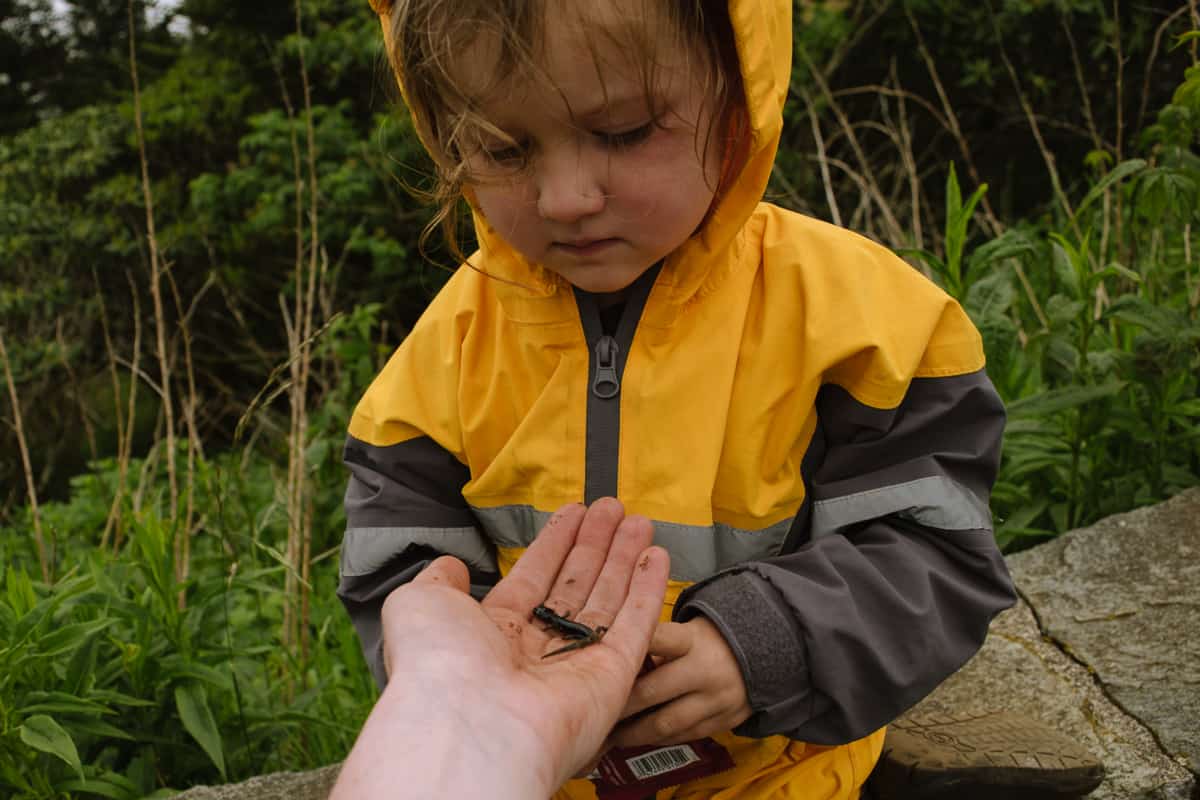
Where to look for salamanders
One thing that all salamanders seem to have in common, is that they are very sneaky. Depending on species, they may burrow under the ground, logs, rocks, boulders, or leaf litter. With such a wide range, while you are out discovering salamanders with your kids it’s probably best to look up what species are native to your area and where they tend to reside.
Terrestrial salamanders
If your local salamanders are terrestrial, take to forests, especially on wet days. Once under the tree canopy, very slowly and carefully look under rocks, fallen logs, or freshwater seepage areas. Just take care to return whatever rocks or logs are moved. You may also want to research your native salamanders’ breeding seasons and seek out seasonal/vernal ponds.
If you do find a salamander, be mindful to not return the log or rock on top of the creature, as they can be easily crushed. One tactic is to return the rock or log first, then gently release the salamander next to where you found it. You’ll be amazed at how quickly their short legs can get them back undercover! If you and the kids are up for it, you can also go forest exploring on a rainy night when salamanders tend to be more active.
Aquatic salamanders
If your area has native aquatic species, go exploring creek beds, bogs, swamps, springs, and ponds. Aquatic salamanders are often easier to find, but harder to catch. They are faster than their land-dwelling cousins. The aquatic salamanders use their tails to propel themselves through the water like little missiles. They also tend to be more camouflaged as compared to the brighter colored terrestrial counterparts.
If you go searching in freshwater habitats, look under rocks near the bank or in creek beds. Lift the rocks slowly and carefully to limit siltation (murky water), which decreases water visibility. And just like you do for terrestrial species, take care to replace all potential cover back into place prior to leaving. Salamanders may be stealthy, but they need the natural cover of rocks, logs, of organic debris for protection and hunting.
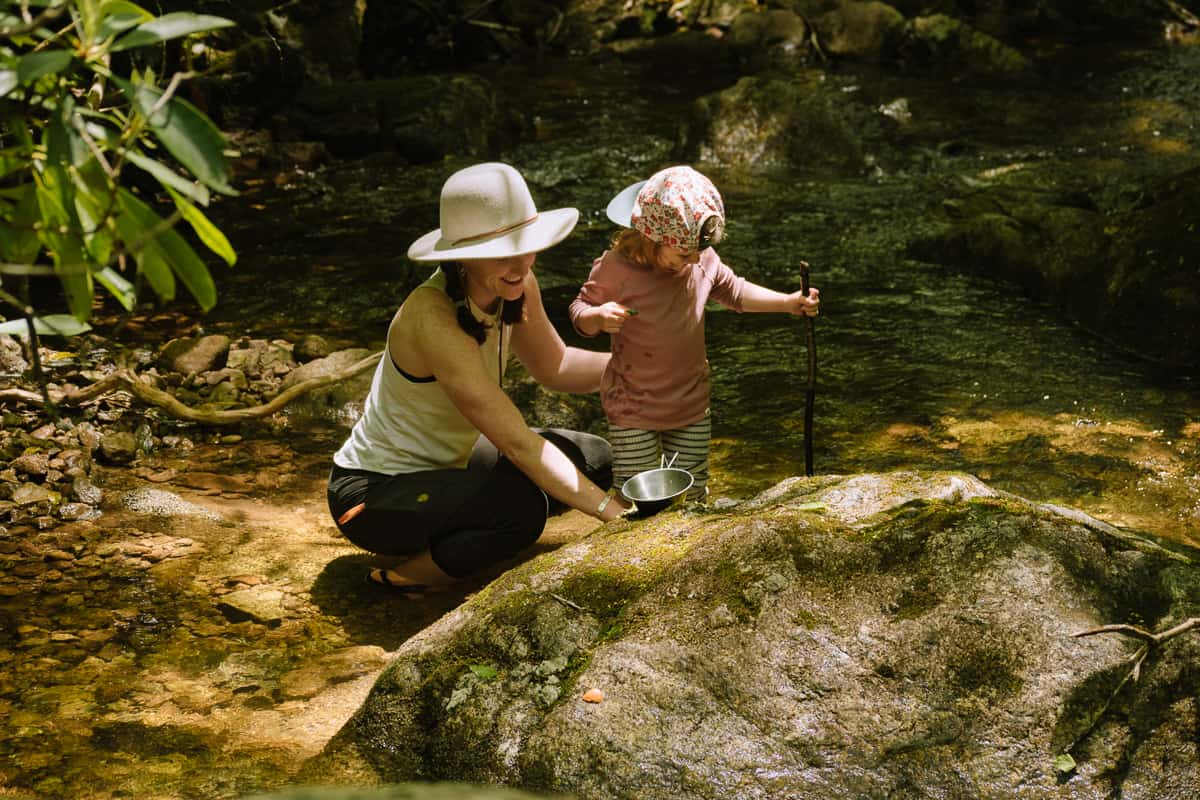
How to handle salamanders
When you are lucky enough to find salamanders, please take care in handling them. Their permeable skin makes them delicate and quite sensitive. Try to remember to wash your hands with soap and water before going out. Make an extra effort to not have any chemicals on your hands including sunblock, bug spray, sanitizer, scented lotions, or any other substances that could be potentially harmful to the amphibians. Many species breathe through their skin and need to stay moist. So, it may be beneficial to wet your hands before touching them.
When attempting to hold them, keep in mind that they can also be very fast. They will squirm and squiggle right out of kids’ paws if given the opportunity. Try to prepare your kids. You don’t want them to clamp down on the fragile critters should they make for an escape. A gentle loose grip is best.
For smaller kids, who may not have the dexterity to safely hold small salamanders, bring along a small cup to put them in temporarily. That way your child can see them up close without harming or overstressing them. After you all have gotten a good look, help empower your kiddos to be good nature stewards by releasing the salamanders right where they were found.
Of note: Some terrestrial species secrete a very sticky mucus when handled as a defense mechanism. The mucus tends to not wash off for a day or two, although in my experience it lost the stickiness within a couple of hours.
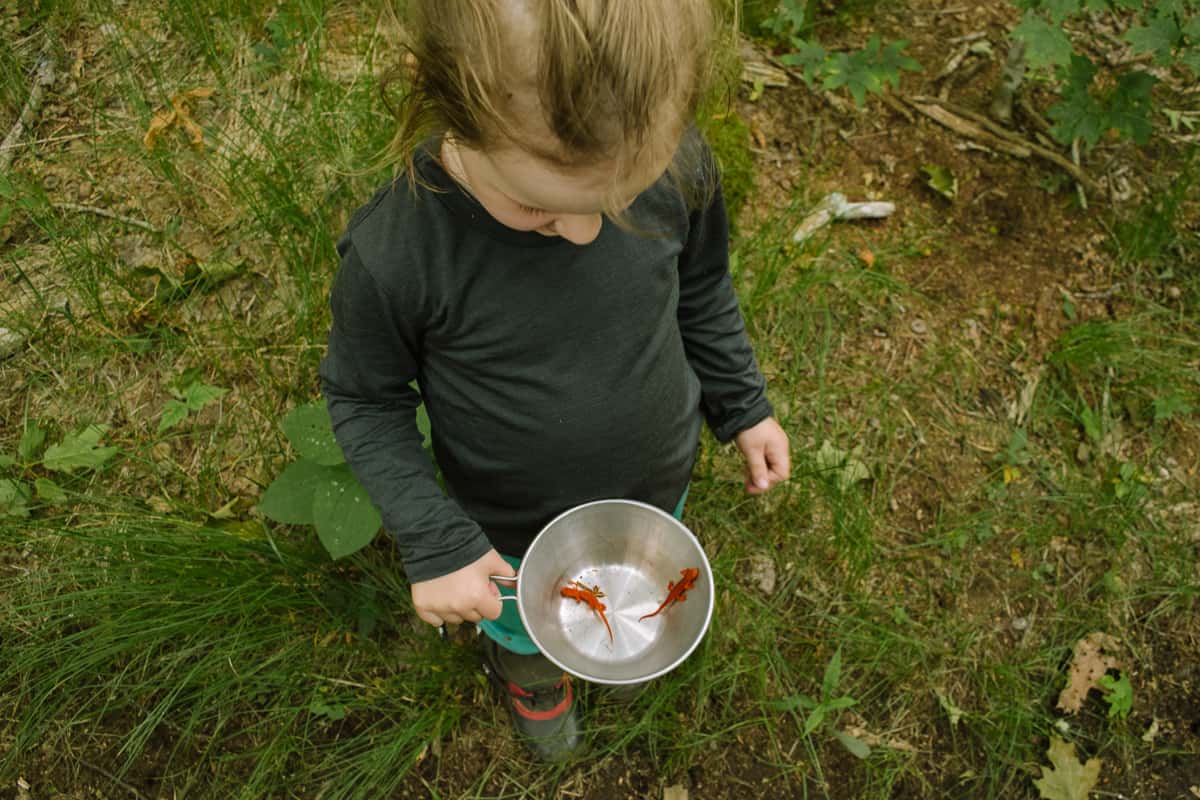
Salamander conservation
Scientists consider all amphibians, including salamanders, as sentinels or bio-indicators. This means that the health of an area’s species, or group of species, is considered an indicator of the overall wellbeing of that habitat or environment. This is because amphibians are extremely sensitive to environmental change. Due to this sensitivity, amphibian populations seem to be declining globally.
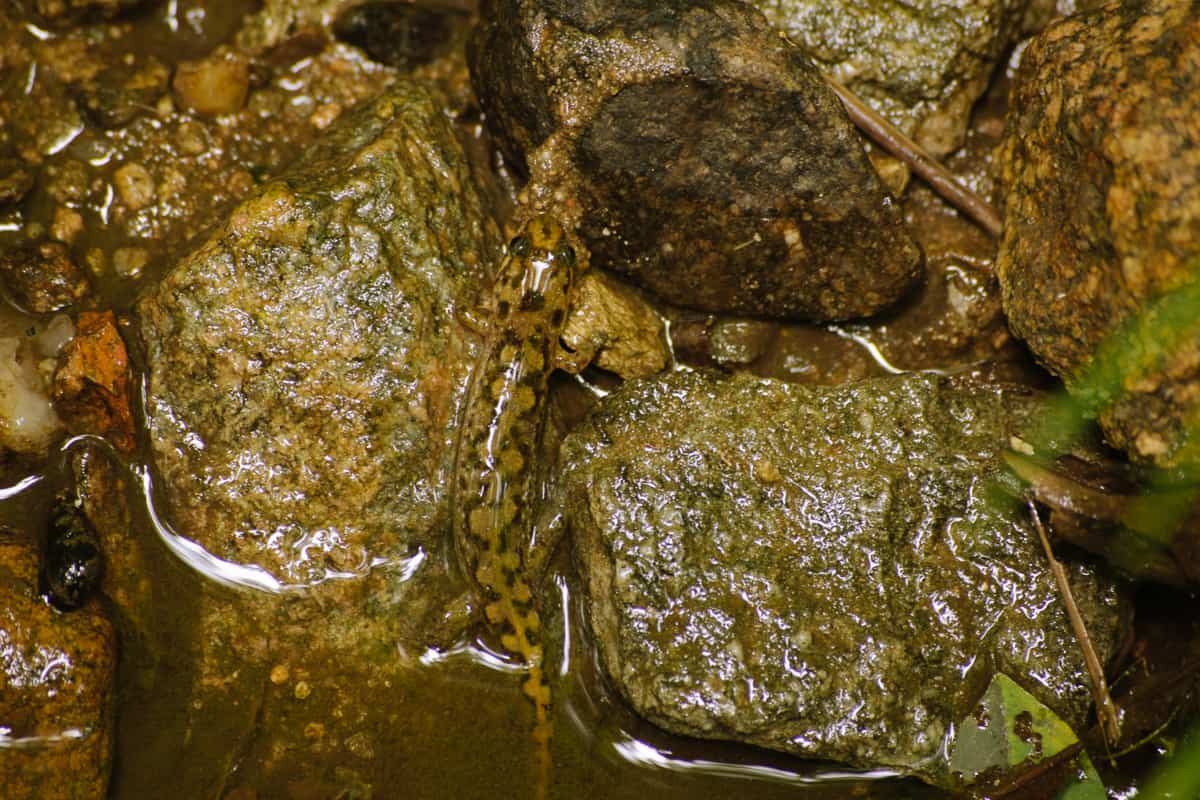
Salamander vulnerability
Salamanders, like frogs, lay unshelled eggs in water. Without outer shells, the eggs are easily damaged by pollutants, ultraviolet radiation, and other disturbing factors. It’s more complicated for terrestrial species who depend on vernal ponds to lay eggs, as seasonal water sources are being increasingly affected by climate change. And as mentioned earlier, salamander’s permeable skin also makes them quite fragile to chemical pollutants. They can’t survive in polluted waterways.

How to help salamanders
All is not lost; we can help protect these amazing creatures. There are simple things we can do to benefit salamanders no matter where we are.
- We can help by ensuring they have shelter. When you see rocks stacked into (unnecessary) “cairns”, dismantle them by gently dispersing the rocks. Removing rocks from creeks and streams to form stacks, causes over-siltation of the waterway and loss of protective shelter for salamanders and other little beasties like crawdads.
- Advocate against using salamanders for fishing bait, and for the humane release of Hellbenders caught by anglers.
- Collect litter we come across while out adventuring, especially trash you can reach at the edges of water sources.
- And if your family is really looking to be a force of change, investigate how you can engage in local habitat restoration efforts in your community.
- Last but certainly not least, help us spread the joy and wonder of these clandestine critters! The more folks know about them, the more folks will care, and the more likely we’ll be able to make a difference.
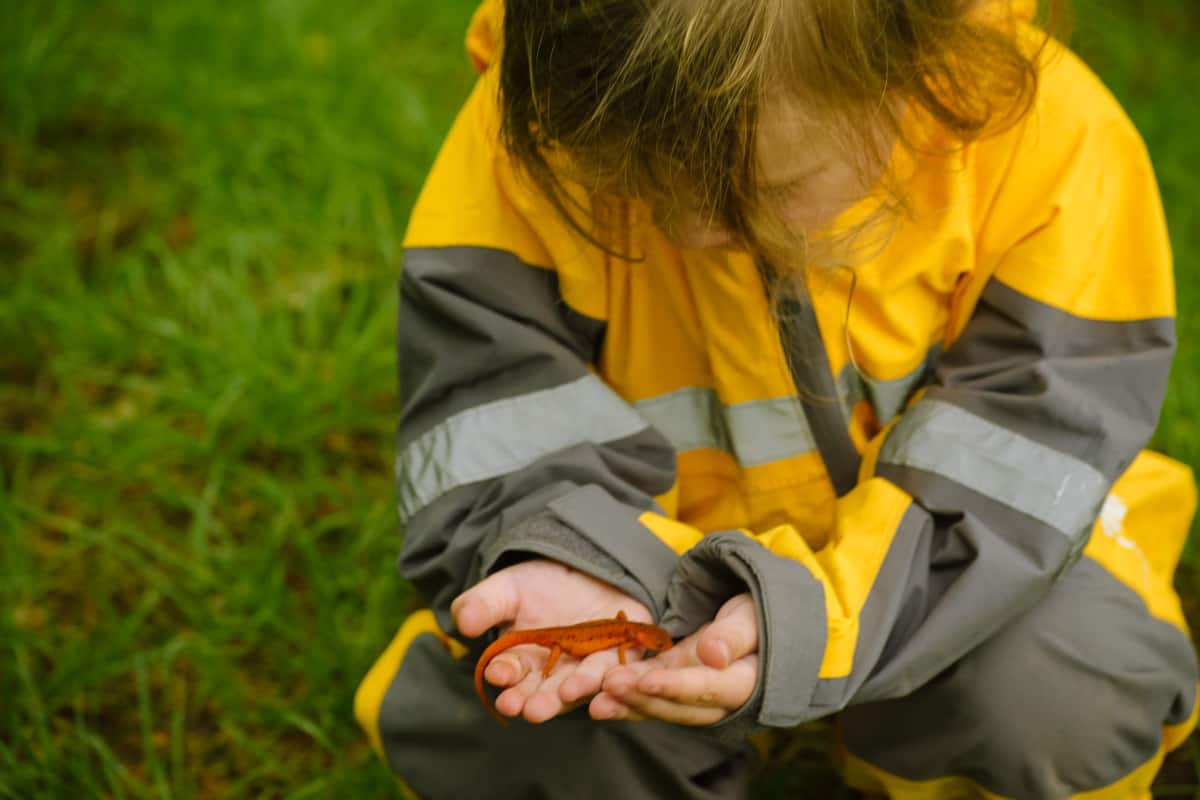
Cool salamander facts for kids
- Salamanders are older than dinosaurs! The earliest found fossil records of salamanders are more than 250 million years old. That’s 40 million years older than the first fossil records of dinos. That means these incredible creatures survived the great extinction events that killed the dinosaurs. No wonder some species (particularly in the cryptobranchidae family) look so prehistoric.
- “Salamander” is Greek for “fire lizard”. The name has its origin in the myth that salamanders can walk through fire. This myth came about in ancient times. People would often see salamanders as they crawled out from logs that had been thrown onto the fire.
- A group of salamanders is referred to as a herd or a congress.
- The axolotl, a native Mexican species, can regenerate missing limbs, eyes, gills, and some organs (cool, right!).
- Colloquial names for salamanders include snot otter, devil dog, lasagna lizard, walking fish, fire lizards, Allegheny alligators, mudpuppies, waterdogs, and baby dragons.
- The biomass of salamanders in America’s southeastern Appalachian forests is greater than all mammals and birds combined.
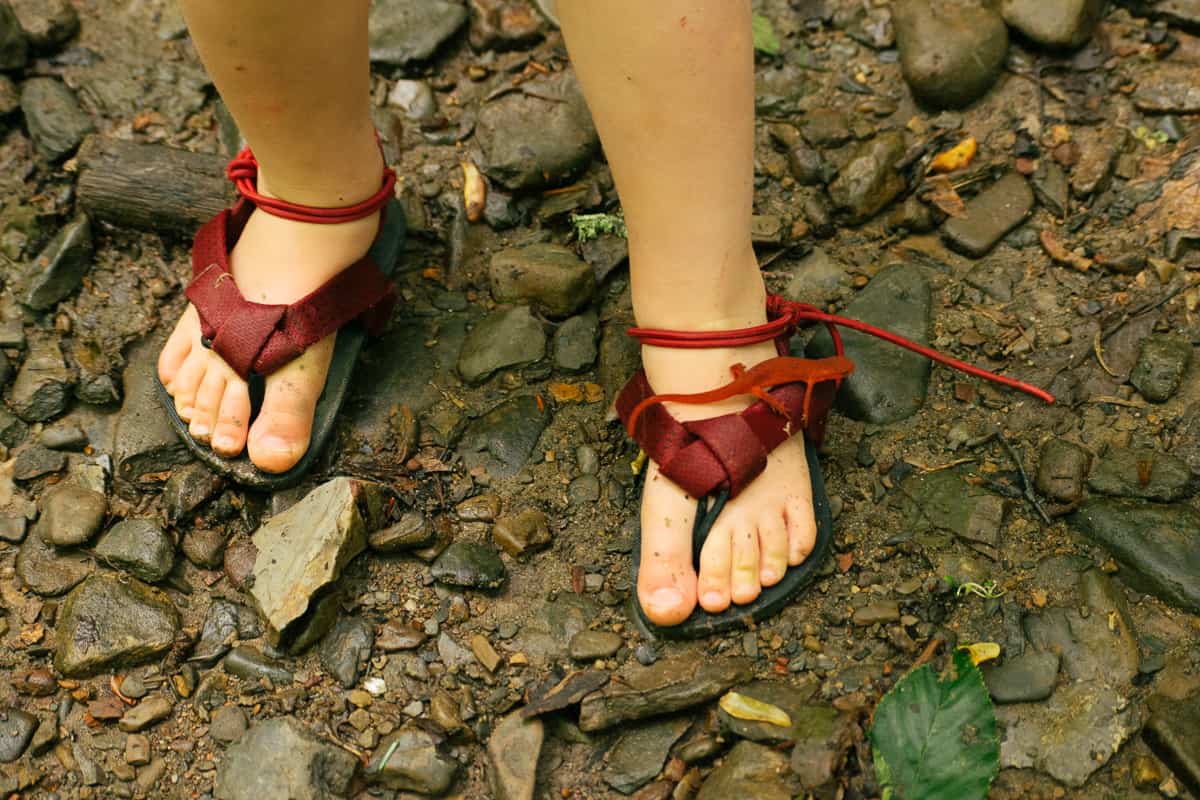
Salamander fun for young children
Bring the outdoors in with salamander toys and books!
Salamander toys
- Beautiful handmade salamander toys by OutsideEverywhere.
- Salamander puppets are a good option too. Folkmanis has a couple options; a mud salamander finger puppet and axolotl.
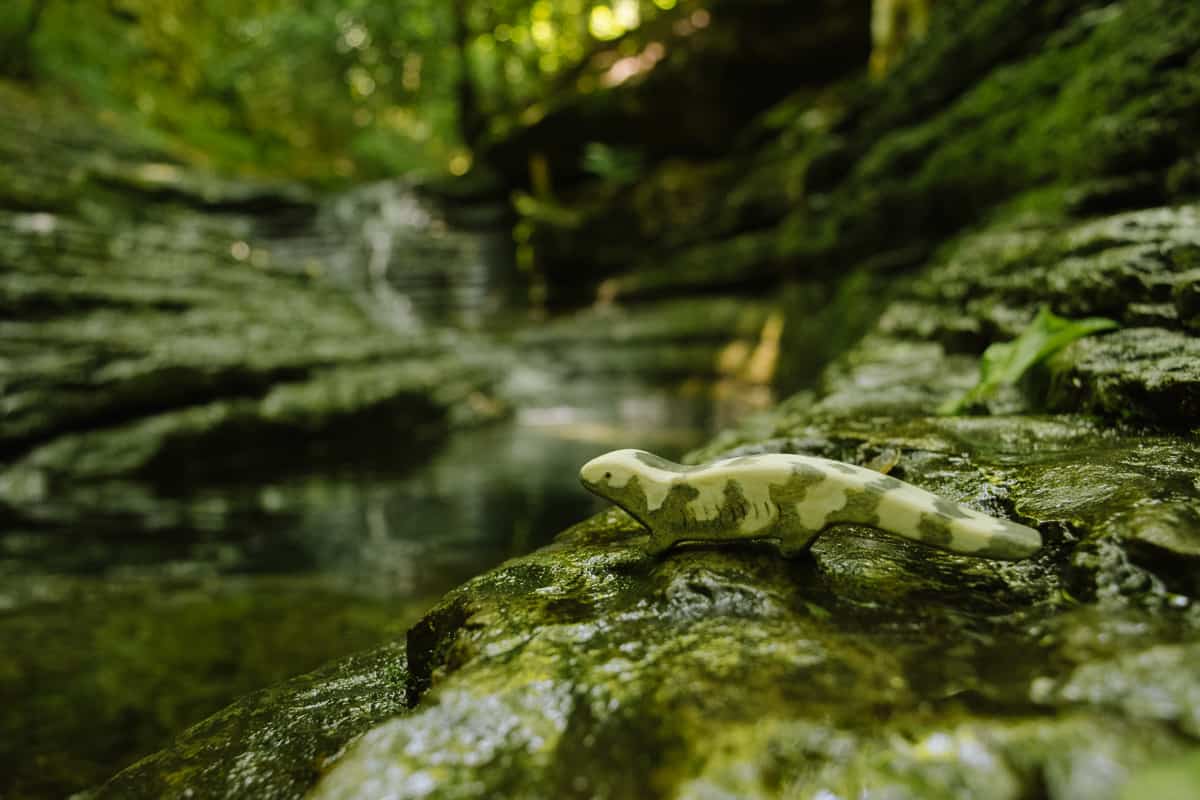

Children’s books about salamanders
- The Salamander Room, by Anne Mazer
- Big Night for Salamanders, by Sarah Marwil Lamstein
- The Great Smoky Mountain Salamander Ball, by Lisa Horstman
References
- Salamanders of the Southeast, 2010, written by Joe Mitchell and Mitch Gibbons
- https://animals.sandiegozoo.org/animals/salamander-and-newt
- https://www.handsontheland.org/environmental-monitoring/salamander-monitoring.html
How are your kids developing a passion for the outdoors?
About the author
Somer is a mama living in southern Appalachia. Somer’s motherhood journey began when her oldest daughter was born with severe congenital heart disease. Avelyn spent the majority of her 18 months of life within a pediatric ICU. Though she lived her life chronically critically ill, Avie was an incredibly loving and joyous child. After her death, Somer and her husband sought solace backpacking a section of the Appalachian Trail. Before long, they discovered their ability to cope seemed to correspond with time spent outdoors.
When it came time to add another kiddo to the mix, bringing the baby along was never a question. In an effort to celebrate the freedom provided by healthy bodies, Somer has hiked her second-born 2k+ miles. Even so, she doesn’t believe grand adventures are necessary to reap nature’s wonder. They just as often revel in mundane evenings in their backyard. The family believes it’s prioritizing time spent outdoors that’s important.
Professionally, Somer has spent the last decade caring for veterans on an acute psychiatric unit as a clinical nurse educator. Over the years she’s become a passionate advocate within the intersectional relationships of mental health, wellness, and the natural world. She truly believes there’s healing and strength to be found outdoors for those who seek it.
You can find Somer online in the following locations:
Instagram: @somerpickel
Comments
One response to “Discovering the Wonders of Salamanders with Kids”
[…] The Roan mountain ecosystem is incredibly diverse and rich. Salamanders are a definite favorite of our family though. If you’d like to learn more about them check out our Salamander article! […]


Leave a Reply